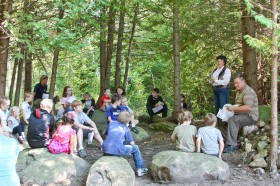Crossroads at Big Creek is thrilled to announce that, thanks to grants from the Raibrook Foundation, the Door County Community Foundation, Learning in Retirement of Door County and several anonymous donors, we will be able to upgrade the multi-media system in the Lecture Hall of the Collins Learning Center.
Last week, we also completed the Hidden Classroom Project, which means we spent a lot of time looking at rocks. The colorful boulders were probably deposited here by Ice Age glaciers, but local rocks often are full of fossils.
On Saturday, September 22, Crossroads will offer a family program on the Fossils of Door County. So what is a fossil? According to the American Heritage Dictionary, it is “a remnant or trace of an organism of a past geologic age, such as a skeleton or leaf imprint, embedded and preserved in the earth’s crust.”
“Preserved” is the operative word. Think of all of the plants and animals which have lived during the past 400 million (or so) years. Most living things died, decomposed and their chemicals were naturally recycled. Very special sets of conditions must be in play for a fossil to be created.
First, the organism had to be buried almost immediately after its death. Mud slides, volcanic ash, or sand storms could have quickly covered an organism. Or an animal living in a shallow water could have settled into the sediment at the bottom of the sea and quickly become buried. Such was the case with Door County fossils.
Geologists believe that when our bedrock was being formed, Door County was probably located just south of the Equator and covered with water. Ancient corals and shellfish thrived. After they died, they settled into the muck and their soft body parts decomposed, but the harder parts…the shells…did not rot.
Under layers of sediments and over an unimaginably long period of time, the buried parts underwent chemical changes during which minerals leached from above seeped into, dissolved and replaced or crystallized the remains of the ancient life. So while fossils are still the shape of the original organisms, they chemically are a rock.
It is through preserved evidence that we are able to learn so much about life in the Silurian Seas. By looking at fossil evidence, we think that this region was covered with a warm, shallow, saltwater sea….or more accurately, a succession of many shallow seas. We learn which creatures lived at the same time and note how, over the ages, they evolved.
When you think about it, scrapbooks are similar to fossils. Scrapbooks preserve evidence of lives and help us understand the past.
Just as evidence of countless generations of creatures are lost to us because we lack fossil evidence, many of our family histories are lost because no effort was made to preserve them. It is bad enough to find boxes of unlabeled photographs and mementos. Now, most people carry their pictorial histories on cell phones or store them in computers that will soon become obsolete.
As part of the Sunday in the Village series, on Sunday, September 16 at 2:00,the Door County Historical Society will offer at Scrapbooking workshop in the Vignes School. Kathy Wendhack will demostrate how to preserve family history in an attractive way.
Also Sunday, the Village Blacksmiths will demostrate their skill at the forge while the Fairland Bluebrass Band provides musical entertainment complements of the Door County Thrivent Chapter between 1:30 and 3:30.


